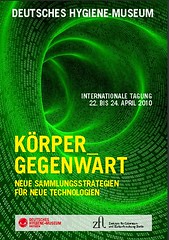Besides the preservation and display of the contemporary medical heritage, one of my major research interests is the methodology of writing the history of contemporary science (see, e.g., The Historiography of Contemporary Science and Technology (1997) and The Historiography of Contemporary Science, Technology and Medicine: Writing Recent Science (with Ron Doel, 2006)).
 Now I am beginning to think about a third volume in the ‘series’ to catch up with new trends in science historiography. One of the most interesting issues — both from a museological and historiographical point of view — is how historians should deal with the growing avalanche of scientific digital documents.
Now I am beginning to think about a third volume in the ‘series’ to catch up with new trends in science historiography. One of the most interesting issues — both from a museological and historiographical point of view — is how historians should deal with the growing avalanche of scientific digital documents.
I.e., how to preserve, utilise, and make sense of the enormous output of digitalised desk and laboratory data for the writing and displaying of contemporary history of science? Not just gigabytes of text documents (like manuscripts, electronic lab notebooks and emails), but also terabytes of quantitative experimental data — not to forget digitalised images and material things that embody such data (such a microarrays and biobanks).
Our guest blogger Martin Fenner wrote a very inspiring post about digital preservation a few weeks ago. “It’s surprising”, Martin concluded, “that we have barely started to think about digital preservation”.
Another scholar who has thought about the problem is university archivist and library administration scientist Christopher Prom, currently a Fulbright Distinguished Scholar at the Centre for Archive and Information Studies, University of Dundee.
Prom is giving a talk here in Copenhagen next Thursday (4 March), titled “Preserving the ‘Papers’ of 21st Century Science”, in which he will review the current state of work in preserving digital records and provide some suggestions regarding methods and tools that archives and others stakeholders can use to make sure that the electronic record of the 21st century will be accessible also in the 22nd. Here’s his abstract:
We cannot understand the full impact of scientific work without access to the correspondence, notes, and other materials that scientists generate on a daily basis. But how, in the digital era, can we best preserve the ‘papers’ generated by scientists? Such records are stored as mere electronic impulses, distributed across many locations, and written in formats that cannot be rendered without machines and software. As a result, rich historical sources, such as correspondence in email format, are at risk. Recent events in East Anglia demonstrate that such records are susceptible to hacking and misrepresentation in the short term. In the long term, they may be even more susceptible to loss through corruption or neglect.
The venue for Prom’s talk is the Niels Bohr Institute, Blegdamsvej 17; it starts at 2.15 pm. Copenhagen historian of physics Finn Aaserud organises the event.



 Now the program has been finalised — and it looks very good! After a plenary discussion on ‘Schauplätze der Schönheit: Klinik, Kunst, Medien und Museen’ on Thursday evening, there follows two days of presentations, most of which seem to be very relevant for the future of medical and science museums:
Now the program has been finalised — and it looks very good! After a plenary discussion on ‘Schauplätze der Schönheit: Klinik, Kunst, Medien und Museen’ on Thursday evening, there follows two days of presentations, most of which seem to be very relevant for the future of medical and science museums: